Posted: April 30th, 2007 | No Comments »
The Imaging the City workshop here at CHI featured a nice set of practices and technologies for representing the urban environment in Human-Computer Interaction. Some of them are strongly related to my current work.
Urban Ritual in Rome: Characterizing the City with High-Resolution Cell Phone Data by Matthew Jull and Carlo Ratti is a follow-up on their work with Real-time rome. Their spatio-temporal analysis show that cell phone activity correlates strongly with the infrastructures and zones of the city (e.g., transportation links, commercial, office, residential zones) and the daily activities (e.g. wake up, commute, work, lunch, dinner, sleep, sports events). These preliminary results suggest that cell phone data can be used to characterize and map urban domains and the cultural signature of its occupants.

The daily activity of people throughout the city is revealed (i.e. wake up, commute, work, lunch, dinner, sleep, sports events etc.)
Personalized City by Continuous Location Logging by Jun Rekimoto and Takashi Miyaki. They propose a city visualization method based on long-term and continuous personal location history generated by WiFi-based location detection methods. Their visualization reveals a person’s “cognitive” map based on the traces left while navigating the urban space. They apply a fisheye-view method to distord the map in order o reflect the person’s location probability density. Therefore, frequently visited area becomes larger on the map. The continuous log of one’s geographical position could be a foundation for various “lifelog” applications, such as memory aid or information organizer (as suggested in Tracing Personal Mobility).

A nice comparison of WiFi in GPS location accuracy in a urban setting

Person’s “cognitive” map based on location history. Fisheye-view to reflect the person’s location probability density. Frequently visited area becomes larger on the map. To be useful in a local search task, it might be more useful to distort the map to reveal the less know areas. I have this experiment using anamorphosis maps in mind for a while now…
How We Watch the City: Popularity and Online Mapsi by Danyel Fisher. He developed Hotmap, a tool that visualizes how people have used Microsoft’s maps.live.com to reveal what parts of the maps they find most compelling. The results show that the vast majority of hits are focused on a fairly small area, following population, suggesting that largely, users currently find use of the tools for looking at natural scenery less compelling then they do city imagery. This work could be extended by show how people “query the city” (e.g. what are the keywords. Something I wanted to find out more about at Urban Mapping). Knowing more about the types of searches and the areas of interests could help the local search community to go beyond the classic, yet irrelevant “closest Starbucks” scenario. Categorizing the different types of granularity in space and time embedded in the queries could help understand how people query space.

The Big Picture: Exploring Cities through Georeferenced Images and RDF Shared Metadata, by Carlo Torniai, Steve Battle and Steve Cayzer. They present a prototype system by on Flickr geotagged images to discover geo-related pictures of a same city taken from different users. The browsing interface, based on different levels of relationship between pictures metadata, allows users to explore cities according to the relations discovered. An extension of the work can be found in Sharing, Discovering and Browsing Geotagged Pictures on the Web”.
Posted: April 28th, 2007 | 2 Comments »
Ian White was kind enough to invite me present my research at today’s Urban Mapping brown bag seminar.

Thanks for the gig, Ian! It is extremely valuable to get insights from people in the field doing real business with geodata. Subsequent to my presentation we discussed the current state of local search and the difficulties to integrate a user-centered perspective. In the generation of their neighborhood datasets, Urban Mapping creates on purpose overlapping areas. However this fuzziness is appreciated by the engineers who have to integrate these types of data in their search engines. In addition, local search engines have been forcing users to search for location-based information by providing an area. Even if need types of queries are available, it is very difficult to make users learn to query based on monument rather than area (what is close to the Empire State Building?).
Posted: April 18th, 2007 | 1 Comment »
I started flooding the database for Tracing the Visitor’s Eye. For instance, I plotted the traces formed by 126853 geotagged photos taken in Switzerland. The transition between the main urban and natural attractions emerge:
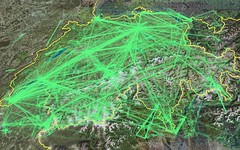
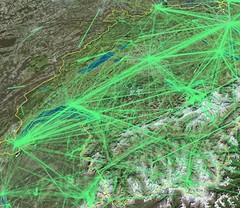

Posted: April 11th, 2007 | No Comments »
Konomi, S., and Roussos, G. Ubiquitous computing in the real world: lessons learnt from large scale rfid deployments. Personal and Ubiquitous Computing (2006).
This article takes part of the train of thoughts on the inherent antagonisms of ubiquitous computing reality and the seamless calm computing vision advocated by some academic research. It does so by examining two fully operational Radio Frequency Identification-based systems: the Oyster card ticketing system used at the London Underground in the UK, and retail applications deployed at the Mitsukoshi departmental stores in Tokyo, Japan. Each case study is analyzed through the terms of technologies, user interactions, and their business and organizational context. As a result, the authors highlight that the real world has concerns that are rarely dealt with in research.
Ubiquitous computing in the real world has concerns that are rarely dealt with in research. Lengthy and costly preparation or upgrade of existing infrastructures; training of employees and users in the new ways of working; controlled introduction of new functionality; features and services to manage risk; unexpected behaviors due to the wider variety of possible real world situations; incremental approach to systems development so as to better identify successful aspects; regard for the economics of systems as a core requirement; and selection of open or closed systems, are all issues that are mostly outside the scope of current ubiquitous computing research, but seem to play a critical role in both case studies we consider here.
As a consequence, so far, the ubicomp of the present is made of isolated islands of functionality rather than a seamlessly connect whole. That brings the authors to define the challenges for ubicomp research around taking into consideration of the constraints of the real world but also in bringing a more user-oriented approach to research practices:
Therein lies the challenge for ubiquitous computing research: how not only to learn about the concerns of those developing systems in the real world but more importantly, how to translate principles, guidelines and models discovered in the context of research into useful tools for building ubiquitous computing systems in the real world. Bringing the two communities closer together and communicating lessons learnt in ubiquitous computing research so as to inform practical system design and development can have profound implications for the success or the failure of the ubiquitous computing vision.
Relation to my thesis: My research on spatial uncertainty revolves around the gap between practice and the state of the art in research. (That is in other words understanding both the concerns of the real world and the expectations of the users to build useful location aware application). This gap is well described by papers such as this one. I also ground my approach on the critique of researchers and technologies that absolve themselves for responsibilities for the present.
Posted: April 11th, 2007 | 1 Comment »
With now the barrier of 20 Million geotagged photos reached, Flickr is arguably the richest publicly accessible massive source of user-disclosed spatio-temporal data.
Relation to my thesis: I am observing emerging mobile/web-based LBS such as Plazes, Jaiku, Twitter, Dopplr to collect spatio-temporal data for my current exploratory work. Yet, so far Flickr proved to be the most promising dataset.
Posted: April 8th, 2007 | No Comments »
I have been perfecting the system to collect and analyze the data for my “Tracing the Visitor’s Eye” experiment. I expect to cover data of a 2+ years period from 11 different cities (plus one region, and a small country). Today, I played around with a small set of 3365 photos and 22110 tags taken by 236 anonymous flickr users (avg of 14.26 photos/photographer) in Barcelona from January 15 until March 1 2007. I focused on the basic temporal aspect of the data to see if the pulse of the city could be extracted. Here are the yearly (2.5 months), weekly and daily patterns revealing “urban heartbeats”:
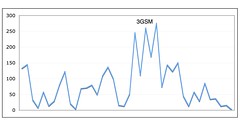
Yearly distribution over the period of January 15 and March 1. Bigger spikes appear between February 10 and February 15 for the 3GSM World Congress. Each weekend is a “urban heartbeat”. Would be interesting to compare how the attendees of 3GSM navigate the city as compared to other tourists.
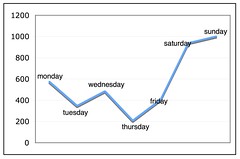
Weekly distribution. As expected, the weekend triggers more activity
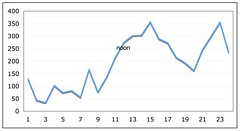
Daily distribution. Peaks in early afternoons and in the evenings. Similar to the graph of the GSM cell activity in the Milan metropolitan area
Of course, things will start to get interesting by crossing the temporal data with the accuracy, tags and spatial data to reveal the “where, what and why”. I am exploring techniques to categorize the photographers (tourists or citizen), create neighborhoods and areas of attractions of points of interests (probably by using the geonames dataset).
I am also observing very closely the experiments on the spatio-temporal data of Twitter (Mapping Twitter, twittervision, Twitter Maps – A Unique View of London) and Dopplr (Playing with sparklines on dopplr data). The very interesting aspect over these is that people not only disclose their history, but mainly the future intentions (Awareness of the future and some thoughts about classification). Studying how people disclose the location of their future intentions could help us understanding how to deliver in terms of location quality and timeliness such information.
Posted: April 6th, 2007 | 2 Comments »
LIFT’07 is long over, yet it is not tool late to write down what I brought back home from my stay in Geneva in February.

Lift conference room. Courtesy of Jan Chipchase.
First I gathered inspiring feedback from my talk. In a pastiche of Don Norman’s The Design of Everyday Thinks, I discussed my perception of how sensor technologies (not necessarily ubicomp types) are currently embedded in our lives. My intention was to suggest that new technologies, no matter how “smart” they become, will not wipe out the evidences of difficulties and constraints of their integration in the real-world. Adam Greenfield’s wake up call on the adoption problem of everyware (video) naturally reinforce these thoughts. However, I humbly take a different perspective than Adam. My observation of passengers break dancing in front of automatic doors in swiss train clearly contrast with Adam’s admiration of ballet performed by women using octopus in the hong-kong transit system. Naoto Fukasawa would describe this graceful and elegant transaction as the inspiring “design desolving in behavior“. In fact, there is one specific assumptions/observations upon which I do not necessarily agree with Adam. First, he is fairly confident that robust ubicomp is around the corner with the deployment of IPv6 and ulra-wide band networks. I find hard to believe that a technology such as WiMAX will prevail and deliver robustness in a foreseeable future. In contrary, it might just add a ston to the current Tower of Babel of technology. There are many types of constraints that prevent designer from applying the key guidelines (i.e. facilitating inadvertence, awareness of engagement and unwillingness to engage) Adam suggests. Responsibility of appropriated does not uniquely hold in designers’ hands, because they must work on top of unstable infrastructures, incompatible standards or limited time for quality assurance. In that line of thought, I only can thank Adam for recommending me Edward Tenner’s book Why Things Bite Back: Technology and the Revenge of Unintended Consequences. I am really glad I finally put my hand on a study of the history of science that exemplify how technological fixes often create bigger problems than the ones they were meant to solve in the first place. It of course reminds me of Paul Virilio’s compelling work on the accident as diagnostic of technology. His masterpiece being most probably L’ accident originel prior to anything else. A small stretch from that, Nicolas pointed to me Steven Casey’s work on technology and design-induced human error. In The Atomic Chef: And Other True Tales of Design, Technology, and Human Error, he comments how technological failures result from the incompatibilities between the way things are designed and the way people actually perceive, think, and act. In my research work on location-aware application, I refer this mismatch, as a social-technical gap (inspired by Ackerman). In that issue, Nicolas recently digged the paper Infrastructures: appropriation, empowerment and reflection that describes how an infrastructure is perceived and conceived, emotionally understood, and interacted with from the first-person perspective of its users. This makes me think of to the concepts of adaptive design and layers, that is giving them the opportunity to users to “slip between layers” of a system/infrastructure.
I could catch up with Nathan Eagle‘s talk that I had partially missed in February. Nathan’s work is extremely relevant to my current experiment of collecting and analyzing spatio-temporal traces. In the second part of his presentation, Nathan discussed his reality mining experiment on inferring social network structure using mobile phone data. His study reveals that it is possible with a fair amount of precision to figure out types of relationships, infer the topology of the social network and understand how groups of people interact. However, so far, the analysis is somehow limited to visualizations.
Less related to my research focus, but equally captivating, I really enjoyed Julian Bleeker’s suggestions on knitting together 1st Life and 2nd Life in a meaningful, habitable and playful fashion; Jan Chipchase sharing his experience of performing field research on illiteracy and technologies; Daniela Cerqui questioning the techno-optimistic values of our western society; Frédéric Kaplan for proposing the notion of “chili computing” and Daniel Kaplan for summarizing all the above, and provoking the audience to rethink our assumption our transparency.
It was a real pleasure to finally meet Scott Smith and ride a train with Jan Chipchase discussing the Japanese addressing system.
Nicolas, Mauro, Sergio, and Adam wrote their own notes and impressions on LIFT07.
Posted: April 5th, 2007 | No Comments »
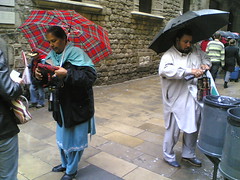
Dynamic BCN. A couple sells umbrellas on the street, at the exit of a museum, seconds after the rain started.
Posted: April 3rd, 2007 | No Comments »
Last night it was our pleasure to invite Nicolas Nova to Mobile Monday Barcelona to discuss about “Mobile Gaming and Beyond“. In his talk “Sinking one’s teeth into new metaphors for mobile gaming“, he presented the directions and potentials he finds interesting for the future of mobile gaming. From a critique of the current state of what he calls “immobile gaming”, Nicolas encouraged mobile game designers to consider 3 other avenues. He exemplified ways to create playful experiences from: motion/mobility, other inputs (e.g. blow in the phone) and other outputs (e.g. TV screen), and taking advantage of the imperfections of the infrastructures.
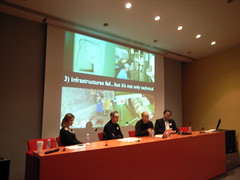
The now almost pervasive “infrastructures fail” slide…
Relation to my thesis: enjoying a stimulating and fruitful collaboration















